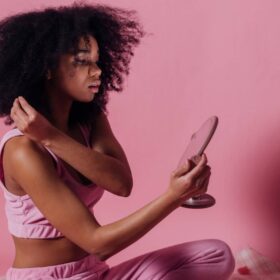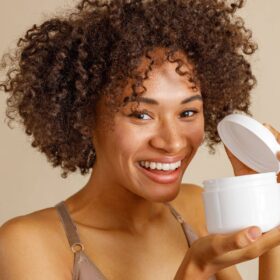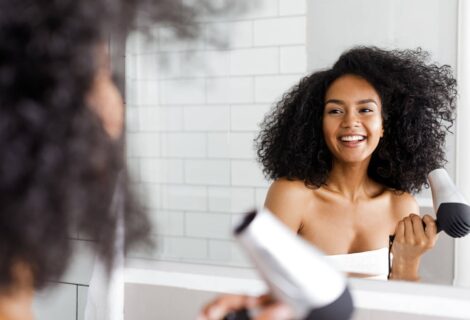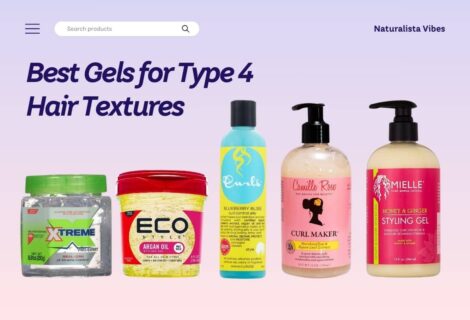This post may contain affiliate links and we may get paid a small commission if you click on a link. Please read our privacy policy and cookies disclosure.
It’s easy to be confused about what hair oils to incorporate into your natural hair care routine. With so many oils on the market, it makes it difficult to figure out what oils to choose. Some oils act as a moisturizing agent whilst other oils work as a sealing agent. They both add great benefits to help you achieve healthy luscious locks. But what one should you be using? Moisturizing vs Sealing oils? This is the question many naturals ask but may not fully understand.
In this article, we’ll be breaking down the differences between the two types of oils to help you understand what to use and when.
Why Oils form an Important part of your hair journey?
Our scalp naturally produces oils, otherwise known as sebum which helps hydrate and protect our hair follicles. Studies show “sebum secretion can be normal, reduced or increased on the scalp of afro textured hair. But our curl pattern can impair the normal distribution of natural oils along the hair shaft from root to tip, giving it a dull and dry look.”1 Which is why using hair oils can help with the additional distribution of the essential oils along the length of your hair strands.
Incorporating hair oils into your natural hair routine improves the overall health of your hair. Some of these benefits include;
- Strengthening your hair strands and cuticles
- Support with moisture retention
- Minimising the risk of breakage
- Promoting hair growth
- Reduces frizziness
- Adds extra shine
You can incorporate oils into your hair in many ways. It’s highly likely you’ve used oils for pre-poo treatments, hot oil treatments, sealing your ends and oiling your scalp. But it’s important to use the correct oils to get optimum results. Regardless of what treatment you’re doing, you’ll be using a moisturizing or sealing oil. Let’s delve into them in a bit more detail.

What are moisturizing oils?
Moisturizing oils penetrate right through the hair shaft to hydrate and moisturize your hair. It has the ability to penetrate through the inner and outer layers, helping you preserve moisture inside your hair follicles and preventing it from leaving. These types of oils support moisture retention and help strengthen your hair whilst reducing the possibility of breakage. You’re more likely to use these oils for hair treatments.
What are sealing oils?
Sealing oils lock in moisture and stop it from leaving your hair strands by sealing it in. They work a little differently to moisturizing oils, as the oils sit on top of the hair strands as opposed to entering the hair shaft. These oils act as a layer of protection to keep moisture in and stop it from evaporating. They tend to be slightly thicker in texture in comparison to moisturizing oils and usually used as a last step in your hair maintenance routine. You’re more likely to use these oils for daily styling and hair maintenance
Examples of Moisturizing VS Sealing Oils


When to use moisturizing vs sealing oils?
Moisturizing oils are best used for hair treatments due to its penetrating effects whilst sealing oils are best for every day styling and maintenance to lock in that moisture and keep it from escaping. Let’s talk about some treatments to help you understand how this works in reality!
Hot oil treatments :
Hot oil treatments are typically used in colder months and helps add extra shine and moisture to your hair. As the oil is warm or hot when applying, it penetrates through the hair shaft quickly as the heat helps open up the hair cuticles. This helps strengthen your hair follicles keeping your hair protected and hydrated. As the treatment is focussed on achieving moisture benefits – its best to use a moisturizing oil.
Pre-poo/Pre shampoo treatments :
Preppoo treatments act as moisturizing treatment which is applied to the scalp prior to shampooing your hair. Using oils with moisturizing benefits helps prepare your hair for cleansing. The oils protect your hair & scalp from being stripped from its natural oils (sebum) when using shampoos which can sometimes be harsh on your coils & curls. Without it, your hair could become extremely dry which could lead to breakage, tangles and knots. Using a moisturizing oil is best for pre-pooing due to its ability to penetrate through the shaft whilst sealing oils might be too heavy and may affect your hair from reaping the full benefits of the treatment.
LOC vs LCO Method :
When using the LOC method, you’ll want to opt for a moisturizing oil as opposed to a sealing oil as you still need to apply your cream afterwards. Sealing oils are good at keeping moisture out. And if you’re applying your cream last – you’ll be locking out all the moisture and hydration benefits.
With the LCO method, you’re applying the oil last after you’ve applied the liquid and cream so you’ll be using a sealing oil on this occasion. The oil acts like a sealant for the liquid and cream helping you keep your hair moisturized for longer. Want to learn more about LOC vs LCO? Click here
Braid Outs & Twist Outs :
When doing braid outs and twists out, you’ve probably used a leave-in conditioner, curl cream or pudding and/or mousse. All these products have moisturizing and hydration ingredients that help your hair become soft and easy to style. Whilst giving it a nice bounce afterwards. In this case, you want to use a sealing oil to lock in the moisture helping the style last longer. You can always do a refresh in between but it’s likely you’ll be rocking the style for at least 5 days and the sealing oil acts as a film to lock in the moisture for that duration.

Summary re; Moisturizing vs Sealing Oils
Moisturizing oils penetrate deep into your hair and get right inside your hair shaft. It works well with water based products due to its penetrating effects and helps nourish and hydrate your hair from the inside out. Always opt for these oils when doing hair treatments that are focussed on hydrating your hair.
Sealing oils are layered on top of your hair after you’ve finished moisturizing and hydrating your hair. The oil acts as a sealant to lock in all the moisture you’ve worked so hard to get into your hair strands. It’s important to note that it also locks out any new moisture from getting into your hair strands. Which is why you should always use it as a last step in your moisture routine.
FAQ’s re; Moisturizing vs Sealing Oils
1: How often should you moisturize and seal?
Depending on the quality of the products you’re using, you should be moisturizing your hair every 3 – 7 days. Everyone’s hair is different and some may be drier than others so you’ll need a bit of trial and error to figure out if it should be slightly less or more. In between washes, you can always spritz your hair with water and follow up with your moisturizer. Just remember that sealing oils act as a film and will stop any new moisture from entering the hair shaft. So only moisturize and seal when you need to as opposed to daily to stop any build up of product sitting on your hair.
2: Can you over moisturize your hair? AND What does moisture overload look like?
The simple answer is YES – you can definitely over moisturize your hair. Having a balance of moisture and protein is vital for healthy hair. You won’t need to use protein as often but it’s good to incorporate it into your routine every 1 to 2 months depending on your hair needs. You’ll know if you’re experiencing moisture overload because your hair will feel limp, mushy and overly soft. You can also tell from your curl pattern as it’ll struggle to hold shape and lack definition. A quick fix is doing a protein treatment or a clay mask which will help detoxify your hair and support the restructure of the cuticles. Remember, protein strengthens your hair and gives it structure. Whilst moisture is equally as important to minimize dryness and breakage. Having the right moisture and protein balance will help your hair thrive.
3: Is Argan Oil a moisturizing or sealing oil?
Argan oil has both moisturizing and sealing benefits. It’s known for penetrating, coating and lubricating your hair whilst protecting it from harsh chemicals. Argan oil is rich in vitamins such as vitamin A, C and E but also loaded in antioxidants and fatty acids. It’s more expensive than other oils bearing in mind its richness but great for scalp and hair care. It basically offers you the best of both worlds in comparison to other oils.
4: Is shea butter moisturizer or sealant?
Shea butter helps seals in moisture and softens the hair. It’s a sealant and not a moisturizer but some people confuse it as a moisturizer because it makes your hair feel more hydrated when applied giving you the illusion of moisture. Shea butter contains butter which seals water based products into the hair but doesn’t hydrate it. It’s filled with fatty acids which helps enhance hydration by reducing evaporation. Shea butter can be found in many products such as deep conditioners, hair creams and treatments. Although it’s a sealant, it also has hydrating benefits due to its water binding properties. So if you do decide to use it as a moisturizer, it’s best to mix it with other ingredients to get the best out of it.
Final Thoughts
We hope this clarifies everything you need to know re; moisturizing vs sealing oils. Oils are a great way of achieving moisture retention in between hair treatments, daily hair maintenance and styling. They’re designed to add moisture and shine to your hair and scalp whilst helping you lock that moisture in for long periods of time. The key is to use the right oils! It’s easy to remember what oil does what via the name i.e. Moisturizing = moisture and Sealing = sealant. Just do some research on oils that fall into the two categories before picking them. We’ve named the most popular ones in the article but feel free to experiment with other oils and if you like you can mix essential oils together to create your own mix.
SOURCES
- Black women’s hair: the main scalp dermatoses and aesthetic practices in women of African ethnicity. Tanus A, Oliveira CCC, Villarreal DJV, Sanchez FAV, Dias MFRG. An Bras Dermatol. 2015;90(4):450-67.
https://www.ncbi.nlm.nih.gov/pmc/articles/PMC4560533/ ↩︎











wwd.com
Howdy! This blog post couldn’t be written any better! Looking at this
post reminds me of my previous roommate! He always kept talking about this.
I will send this article to him. Fairly certain he’s going to
have a very good read. I appreciate you for sharing!
NaturalistaVibes
Thanks you so much for the feedback, I’m glad you found it informative. I hope he enjoy’s reading it! And thanks for sharing.